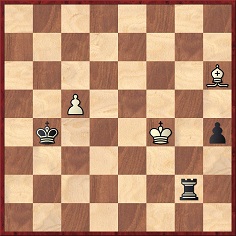
Edward Winter
Mattison’s Chess Endgame Studies by T.G. Whitworth (published by the BCM in 1987) is a compendium of all available studies by the great Latvian composer (1894-1932). Both the annotations and the overall presentation are beautifully neat, another strong point being Alexander Hildebrand’s Introduction.
Studies 37, 38 and 39 show how Mattison developed and reworked an intriguing stalemate idea. Number 39 is given below:

Latvis, 1924
White to move and draw
Solution: 1 c6 h3 2 c7 Rc2 (or ...Rg8) 3 c8(Q) Rxc8 4 Kg3 h2 5 Bd2+ Kb3 6 Kg2 Rc2 7 Kh1 Rxd2 Stalemate.
We happen to recall that the same motif is to be found in the play arising from the following position, which we take from page 39 of Tablas by L. Verjovsky (Barcelona, 1973):
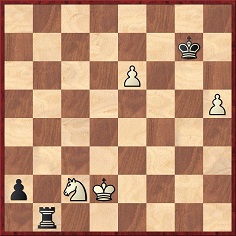
‘44 h6+! Kxh6 45 e7 Rb8 46 Kc1 Kg7 47 e8(Q)! Rxe8 48 Kb2 Re2 49 Ka1! Rxc2 Drawn.’
This position is labelled ‘Teichman-Marbl, Leipzig, 1913’, but, despite the precise move numbers, it is difficult not to have suspicions. Can a reader trace the game or the position elsewhere? Presumably Richard Teichmann is meant, but we can hardly believe that Black was the problemist Murray Marble (1885-1919).
The same book (pages 39-40) gives a further example of the theme, ‘Gusev-Jugovitski, Alma Ata, 1958’:
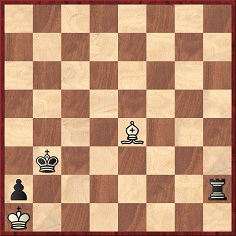
White played 70 Bg2 (‘??’) and had to resign after 70...Ka3 71 Bf1 Rc2. He could have forced a draw by 70 Bd5+ Ka3 71 Bg2 Rh5 72 Bd5.
(1658)
From Ken Whyld (Caistor, England):
‘I looked in Verkhovsky’s Nichya! (second edition, Moscow, 1979) to see how the games were given there, and they are still Teichman and Marbl (but Gusev’s opponent is Zhukhovitsky). There was another Teichmann active at that time, a committee member of the Berlin-Treptow club, but I know nothing about him. Murray Marble is quite unlikely.’
(1699)
René Olthof (Rosmalen, the Netherlands) writes:
‘Going through volume 45 of Chess Informant, I noticed in the endgame section (page 382) the game Hedge-Palatnik, Calicut, 1988, which is a neat addition to C.N. 1658. In fact, it is an exact mirror image of the annotation given to Gusev v Zhukhovitsky, Alma Ata, 1958.’
From Jack O’Keefe (Ann Arbor, MI, USA):
‘C.N. 1740 pointed out that Hedge-Palatnik, Calicut, 1988 was anticipated by Gusev-Zhukhovitsky, Alma Ata, 1958. As shown in Das 1 x 1 des Endspiels by Staudte and Milescu (page 66), the latter game was anticipated by a Mouterde endgame study in La Stratégie, 1923 [sic; 1916]:
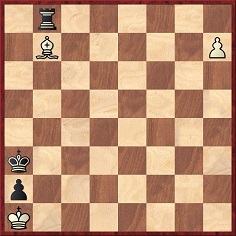
1 h8(Q) Rxh8 2 Bd5 Rh2 3 Bg2 Drawn. Since both Gusev and GM Palatnik lost a drawn position, this is one more argument for the practical value of studying composed endings.’
(1839)
Christian Sánchez (Rosario, Argentina) mentions that the position in C.N. 1658 was given on pages 236-237 of How to Play Chess Endings by E. Znosko-Borovsky (London, 1940), the caption being ‘Teichmann v N., Berlin, 1913’.
Was White indeed Richard Teichmann, and how did the name ‘Marbl’ become involved?
(5201)
Hans-Georg Kleinhenz (Munich, Germany) points out that the game conclusion was given on page 335 of Die Schachwelt, 21 December 1912:
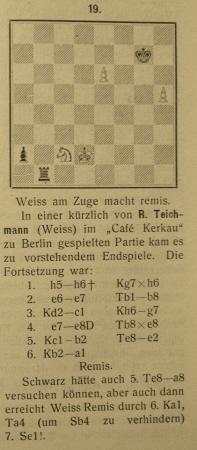
Our correspondent comments that since Richard Teichmann was a contributor to Die Schachwelt the item is likely to be based on first-hand information.
(5212)
See also Stalemate and Chess: Stalemate by Self-Blockade.
To the Chess Notes main page.
To the Archives for other feature articles.
Copyright: Edward Winter. All rights reserved.